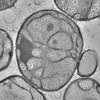+ Open data
Open data
- Basic information
Basic information
| Entry | Database: EMDB / ID: EMD-2363 | |||||||||
|---|---|---|---|---|---|---|---|---|---|---|
| Title | Electron tomogram through a Gemmata obscuriglobus cell | |||||||||
 Map data Map data | Tomographic reconstruction through a whole gemmata obscuriglobus cell. | |||||||||
 Sample Sample |
| |||||||||
 Keywords Keywords |  endomembrane / endomembrane /  eukaryogenesis / eukaryogenesis /  electron tomography electron tomography | |||||||||
| Biological species |   Gemmata obscuriglobus (bacteria) Gemmata obscuriglobus (bacteria) | |||||||||
| Method |  electron tomography / electron tomography /  cryo EM / cryo EM /  negative staining negative staining | |||||||||
 Authors Authors | Santarella-Mellwig R / Pruggnaller S / Roos N / Mattaj IW / Devos DP | |||||||||
 Citation Citation |  Journal: PLoS Biol / Year: 2013 Journal: PLoS Biol / Year: 2013Title: Three-dimensional reconstruction of bacteria with a complex endomembrane system. Authors: Rachel Santarella-Mellwig / Sabine Pruggnaller / Norbert Roos / Iain W Mattaj / Damien P Devos /  Abstract: The division of cellular space into functionally distinct membrane-defined compartments has been one of the major transitions in the history of life. Such compartmentalization has been claimed to ...The division of cellular space into functionally distinct membrane-defined compartments has been one of the major transitions in the history of life. Such compartmentalization has been claimed to occur in members of the Planctomycetes, Verrucomicrobiae, and Chlamydiae bacterial superphylum. Here we have investigated the three-dimensional organization of the complex endomembrane system in the planctomycete bacteria Gemmata obscuriglobus. We reveal that the G. obscuriglobus cells are neither compartmentalized nor nucleated as none of the spaces created by the membrane invaginations are closed; instead, they are all interconnected. Thus, the membrane organization of G. obscuriglobus, and most likely all PVC members, is not different from, but an extension of, the "classical" Gram-negative bacterial membrane system. Our results have implications for our definition and understanding of bacterial cell organization, the genesis of complex structure, and the origin of the eukaryotic endomembrane system. | |||||||||
| History |
|
- Structure visualization
Structure visualization
| Movie |
 Movie viewer Movie viewer |
|---|---|
| Structure viewer | EM map:  SurfView SurfView Molmil Molmil Jmol/JSmol Jmol/JSmol |
| Supplemental images |
- Downloads & links
Downloads & links
-EMDB archive
| Map data |  emd_2363.map.gz emd_2363.map.gz | 2.6 GB |  EMDB map data format EMDB map data format | |
|---|---|---|---|---|
| Header (meta data) |  emd-2363-v30.xml emd-2363-v30.xml emd-2363.xml emd-2363.xml | 6.9 KB 6.9 KB | Display Display |  EMDB header EMDB header |
| Images |  EMD-2363-Gemmata_2363.tif EMD-2363-Gemmata_2363.tif | 764.5 KB | ||
| Others |  g3d_model_11603.avi.gz g3d_model_11603.avi.gz | 35.3 MB | ||
| Archive directory |  http://ftp.pdbj.org/pub/emdb/structures/EMD-2363 http://ftp.pdbj.org/pub/emdb/structures/EMD-2363 ftp://ftp.pdbj.org/pub/emdb/structures/EMD-2363 ftp://ftp.pdbj.org/pub/emdb/structures/EMD-2363 | HTTPS FTP |
-Related structure data
- Links
Links
| EMDB pages |  EMDB (EBI/PDBe) / EMDB (EBI/PDBe) /  EMDataResource EMDataResource |
|---|
- Map
Map
| File |  Download / File: emd_2363.map.gz / Format: CCP4 / Size: 2.9 GB / Type: IMAGE STORED AS SIGNED BYTE Download / File: emd_2363.map.gz / Format: CCP4 / Size: 2.9 GB / Type: IMAGE STORED AS SIGNED BYTE | ||||||||||||||||||||||||||||||||||||||||||||||||||||||||||||||||||||
|---|---|---|---|---|---|---|---|---|---|---|---|---|---|---|---|---|---|---|---|---|---|---|---|---|---|---|---|---|---|---|---|---|---|---|---|---|---|---|---|---|---|---|---|---|---|---|---|---|---|---|---|---|---|---|---|---|---|---|---|---|---|---|---|---|---|---|---|---|---|
| Annotation | Tomographic reconstruction through a whole gemmata obscuriglobus cell. | ||||||||||||||||||||||||||||||||||||||||||||||||||||||||||||||||||||
| Voxel size | X=Y=Z: 15 Å | ||||||||||||||||||||||||||||||||||||||||||||||||||||||||||||||||||||
| Density |
| ||||||||||||||||||||||||||||||||||||||||||||||||||||||||||||||||||||
| Symmetry | Space group: 1 | ||||||||||||||||||||||||||||||||||||||||||||||||||||||||||||||||||||
| Details | EMDB XML:
CCP4 map header:
| ||||||||||||||||||||||||||||||||||||||||||||||||||||||||||||||||||||
-Supplemental data
-Others
- Sample components
Sample components
-Entire : Gemmata obscuriglobus cell
| Entire | Name: Gemmata obscuriglobus cell |
|---|---|
| Components |
|
-Supramolecule #1000: Gemmata obscuriglobus cell
| Supramolecule | Name: Gemmata obscuriglobus cell / type: sample / ID: 1000 / Number unique components: 1 |
|---|
-Supramolecule #1: Gemmata obscuriglobus
| Supramolecule | Name: Gemmata obscuriglobus / type: organelle_or_cellular_component / ID: 1 / Recombinant expression: No / Database: NCBI |
|---|---|
| Source (natural) | Organism:   Gemmata obscuriglobus (bacteria) / Strain: DSM-5831 Gemmata obscuriglobus (bacteria) / Strain: DSM-5831 |
-Experimental details
-Structure determination
| Method |  negative staining, negative staining,  cryo EM cryo EM |
|---|---|
 Processing Processing |  electron tomography electron tomography |
| Aggregation state | cell |
- Sample preparation
Sample preparation
| Staining | Type: NEGATIVE Details: High pressure frozen/freeze substituted in 0.5% uranyl acetate |
|---|---|
| Vitrification | Cryogen name: NITROGEN / Instrument: OTHER Method: high pressure frozen with 100 micrometer deep carriers |
- Electron microscopy
Electron microscopy
| Microscope | FEI TECNAI F30 |
|---|---|
| Electron beam | Acceleration voltage: 300 kV / Electron source:  FIELD EMISSION GUN FIELD EMISSION GUN |
| Electron optics | Illumination mode: FLOOD BEAM / Imaging mode: BRIGHT FIELD Bright-field microscopy / Nominal magnification: 15500 Bright-field microscopy / Nominal magnification: 15500 |
| Sample stage | Specimen holder model: OTHER / Tilt series - Axis1 - Min angle: -60 ° / Tilt series - Axis1 - Max angle: 60 ° / Tilt series - Axis1 - Angle increment: 1 ° |
| Date | Jun 30, 2010 |
| Experimental equipment |  Model: Tecnai F30 / Image courtesy: FEI Company |
- Image processing
Image processing
| Final reconstruction | Software - Name:  IMOD / Number images used: 120 IMOD / Number images used: 120 |
|---|
 Movie
Movie Controller
Controller





